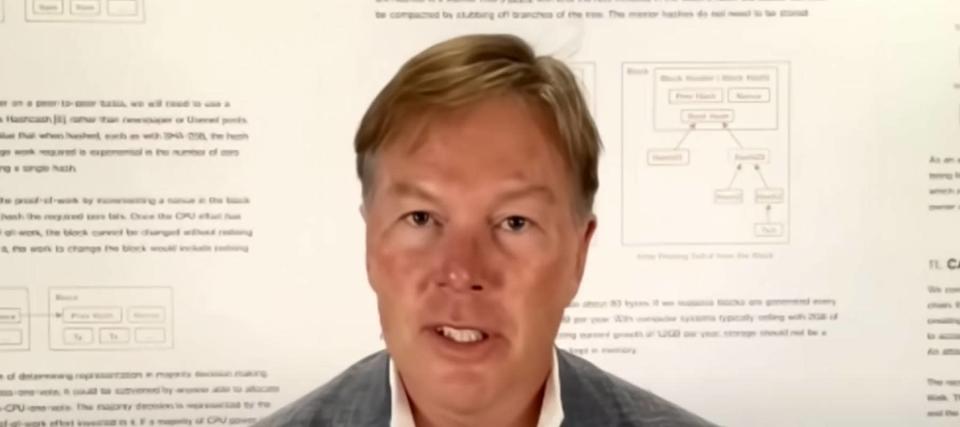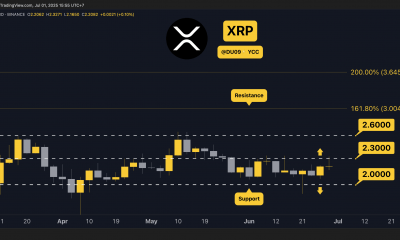Uncategorized
‘The biggest Ponzi scheme in history’: This CEO warns that the Fed’s strategy has created a giant bubble in housing. Here’s what he likes for protection


The Fed is tasked with a dual mandate: to ensure price stability and aim for maximum employment.
But according to Dan Morehead, CEO of crypto hedge fund giant Pantera Capital, there’s a third thing that the Fed has been doing — running a Ponzi scheme.
In his latest Blockchain Letter, Morehead says that the Fed’s “manipulation of the government and mortgage bond markets” is “the biggest Ponzi scheme in history.”
The expert investor even issued a warning on CNBC last week, saying that it’s likely that a “recession is coming.”
Let’s take a closer look at what he means.
Don’t miss
Federal funds rate
Morehead argues that the Fed made a big policy mistake by keeping the federal funds rate far too low.
“The difference between inflation (their mandate) and their policy tool (fed funds) is much larger than at any point in history — including the disastrous 1970s,” he writes.
“They left rates at zero. Fed funds were 1.55% before the pandemic. They’ve just gotten overnight rates to back where they were before the pandemic policy eruption when inflation was only 2.30%.”
As we know very well by now, inflation is no longer at 2.30%. The latest Labor Department report showed that consumer prices rose 8.6% in May from a year ago, marking the biggest increase since December 1981.
And even that official reading was not accurate because it does not measure housing inflation in real time, argues Morehead.
Instead, the official CPI measures housing inflation using something called owner’s equivalent rent — how much it would cost a homeowner to live in their home if they were renting — and that metric only went up 5.1% year over year.
If you’ve been in the market to buy or rent a property, you’d know prices have gone up way more than that. The government says it uses owner’s equivalent rent because it’s only trying to measure the change in the cost of shelter while removing the investment aspect of homebuying.
Morehead instead looks at the S&P CoreLogic Case-Shiller U.S. National Home Price Index, a leading measure of U.S. residential real estate prices that can be viewed as a barometer of the housing market. It jumped 20.6% year over year, and Morehead says that if we use that instead of owner’s equivalent rent to calculate inflation, CPI would have gone up 12.5%.
To tame spiking inflation, Morehead says that the Fed still needs to raise interest rates “by three or four hundred basis points.”
Manipulation of the bond market
While the low interest rate policy was a mistake, Morehead says, it is “dwarfed” by the Fed’s manipulation of the government and mortgage bond markets.
He suggests that previously, the Fed let free market actors like pension plans, mutual funds and insurance companies do the lending — but things changed in 2020.
“[W]hen the Fed got into the mortgage lending business, they really went for it. They completely crowded out all other lenders.”
And that led to a huge increase in housing prices.
“They forced 30-year mortgage rates to hit 2.68%, basically daring people not to buy a house (or two or three), which would obviously create a bubble in housing, which itself contributed to a labor shortage as two million Americans retired early or otherwise left the workforce.”
Officials argue that the Fed’s purchases of securities were essential to “keep markets working” during the pandemic and “convey to the public that the Fed stands ready to backstop important parts of the financial system.”
But when you can borrow money at 2.68% to buy properties that are going up 20% in value per year on average, both homeowners and investors are going to go for it, explains Morehead.
“Over the past two years the Fed bought government and mortgage bonds equivalent to over 200% of all mortgage lending in the U.S.”
While that doesn’t match the exact definition of a Ponzi scheme, Morehead argues that the Fed’s easy money policies has created a huge housing bubble.
Crypto to the rescue?
All of that does not bode well for the U.S. economy.
Plenty of experts — including Morehead — are calling for a recession. But investors are already feeling the pain. With the S&P 500 down 20% year to date, many stocks are already in a bear market.
The Fed, on the other hand, is more optimistic. Last month, Fed Chair Jerome Powell said the U.S. economy is in “strong shape” and “overall the U.S. economy is well positioned to withstand tighter monetary policy.”
Morehead expects interest rate hikes to impact bonds, stocks and real estate. But there are asset classes that are less correlated with the interest rate markets.
“I can easily see a world in, say, a year when stocks are down, bonds are down, you know, real estate’s down, but crypto is rallying and trading on its own — very much like gold does, or soft commodities like corn, soybeans all doing very well.”
Morehead’s Pantera Capital specializes in blockchain technology. It launched the first cryptocurrency fund in the U.S. in 2013.
That said, Morehead did note that crypto is “very correlated with risk assets.”
Bitcoin — the world’s largest cryptocurrency — is down 57% year to date but has still returned over 900% over the past five years.
What to read next
This article provides information only and should not be construed as advice. It is provided without warranty of any kind.
Uncategorized
BofA Securities maintains Amazon.com at ‘buy’ with a price target of $154.00
Uncategorized
Six people in critical condition, one still missing after Paris blast – prosecutor

5/5
© Reuters. French firefighters and rescue forces work after several buildings on fire following a gas explosion in the fifth arrondissement of Paris, France, June 21, 2023. REUTERS/Gonzalo Fuentes
2/5
PARIS (Reuters) – Six people remained in a critical condition and one person was believed still missing on Thursday, one day after a blast ripped through a street near Paris’ historic Latin Quarter, the city’s public prosecution office said. “These figures may still change,” prosecutor Maylis De Roeck told Reuters in a text message, adding that around 50 people had been injured in the blast, which set buildings ablaze and caused the front of one to collapse onto the street. Of two people initially believed missing, one has been found in hospital and is being taken care of, the prosecutor said, adding: “Searches are ongoing to find the second person.” Authorities have not yet said what caused the explosion, which witnesses said had followed a strong smell of gas at the site. The explosion led to scenes of chaos and destruction in the historic Rue Saint Jacques, which runs from the Notre-Dame de Paris Cathedral to the Sorbonne University, just as people were heading home from work. It also destroyed the facade of a building housing the Paris American Academy design school popular with foreign students. Florence Berthout, mayor of the Paris district where the blast occurred, said 12 students who should have been in the academy’s classrooms at the time had fortunately gone to visit an exhibition with their teacher.
“Otherwise the (death toll) could have been absolutely horrific,” Berthout told BFM TV. She said three children who had been passing by at the time were among the injured, although their lives were not in danger.
Uncategorized
4 big analyst cuts: Alcoa & DigitalOcean shares drop on downgrades

© Reuters.
Here is your Pro Recap of the biggest analyst cuts you may have missed since yesterday: downgrades at Alcoa, DigitalOcean, Teleflex, and Xcel Energy.InvestingPro subscribers got this news in rapid fire. Never be left in the dust again.Alcoa stock drops on Morgan Stanley downgrade Alcoa (NYSE:) shares fell more than 3% pre-market today after Morgan Stanley downgraded the company to Underweight from Equalweight and cut its price target to $33.00 from $43.00, as reported in real time on InvestingPro.The firm sees a significant decline in consensus estimates, and as negative earnings revisions materialize, it believes the stock will face downward pressure and underperform.The analyst’s estimates for EBITDA in Q2, 2023, and 2024 are substantially lower than the consensus. The stock is currently trading above its historical average. The firm said its downward revisions in earnings estimates and price target are attributed to the company’s high operating leverage to aluminum prices.DigitalOcean stock plunges on downgradePiper Sandler downgraded DigitalOcean (NYSE:) to Underweight from Neutral with a price target of $35.00. As a result, shares plunged more than 5% pre-market today.The company reported its last month, with revenue beating the consensus estimate, while EPS coming in worse than expected. Furthermore, the company provided a strong outlook, which was above the Street estimates.2 more downgradesTeleflex (NYSE:) shares fell more than 3% yesterday after Needham downgraded the company to Hold from Buy, noting that UroLift expectations may still be too high.According to Needham, their checks indicate that urologists are reducing their use of UroLift due to its retreatment rates, reimbursement cuts, and increasing use of competing procedures. This is also supported by their Google Trends data analysis, which indicates decreasing search interest in UroLift.BMO Capital downgraded Xcel Energy (NASDAQ:) to Market Perform from Outperform and cut its price target to $64.00 from $69.00 to reflect the lower-than-expected terms of the company’s regulatory settlement in Colorado.Amid whipsaw markets and a slew of critical headlines, seize on the right timing to protect your profits: Always be the first to know with InvestingPro.Start your free 7-day trial now.

 Forex3 years ago
Forex3 years agoForex Today: the dollar is gaining strength amid gloomy sentiment at the start of the Fed’s week

 Forex3 years ago
Forex3 years agoUnbiased review of Pocket Option broker

 Forex3 years ago
Forex3 years agoDollar to pound sterling exchange rate today: Pound plummeted to its lowest since 1985

 Forex3 years ago
Forex3 years agoHow is the Australian dollar doing today?

 Cryptocurrency3 years ago
Cryptocurrency3 years agoWhat happened in the crypto market – current events today

 World3 years ago
World3 years agoWhy are modern video games an art form?

 Commodities3 years ago
Commodities3 years agoCopper continues to fall in price on expectations of lower demand in China

 Economy3 years ago
Economy3 years agoCrude oil tankers double in price due to EU anti-Russian sanctions


























